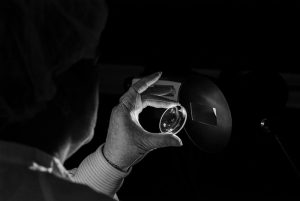
The surface quality of an optical component is an evaluation of the surface imperfections, such as scratches and digs, which may be caused during the manufacturing or handling process. Surface quality is more important for laser applications than imaging applications because surface imperfections can be the initiating sites for laser-induced damage. Sensitive systems where maximum signal strength is essential can also suffer from throughput variations and increased scattering from surface imperfections. Optics used with UV wavelengths require tighter surface quality tolerances than optics used with visible or IR systems because shorter wavelengths experience higher amounts of scatter.
The specified surface quality directly impacts cost, therefore over-specifying your optics and using a better surface quality than required will unnecessarily increase costs. This makes understanding surface quality specifications and how they impact system performance essential to the success and cost-effectiveness of a system. There are several standards for specifying surface quality such as U.S. Military Performance Specification MIL-PRF-13830B and ISO 10110.
U.S. Standard MIL-PRF-13830B
The U.S. Military Performance Specification MIL-PRF-13830B describes surface quality using a “scratch” number followed by a “dig” number based on calibrated standards prescribed therein. The scratch number is one of the following arbitrary numbers: 10, 20, 40, 60, or 80, where the brightness of scratches increases from 10 to 80. This number is not an exact measurement, only an indication of the best match of component scratch brightness with calibrated standard scratch brightness. The inspection occurs under specified darkfield illumination conditions, but because it is a subjective visual inspection the results can vary from inspector to inspector.

However, the dig number is a measurable quantity: the diameter of the largest component dig, given in 1/100 of millimeters. For example, a component with a 0.4mm diameter dig is represented with a dig number of 40 and one with a 0.2mm diameter with a dig number of 20. Once all scratches and digs have been quantified, determining the number of allowable defects is required. This number is determined as follows:
Scratches
The sum of all scratch lengths with the specified scratch number will not exceed 1/4 of the diameter of the optic. For non-circular optics, the diameter of a circle with an area equal to that of the optic should be used.
Digs
The total number of allowable maximum size digs will not exceed the diameter divided by 20. The sum of all dig diameters will be less than or equal to twice the total number of allowable maximum sized digs multiplied by the specified dig number.
An optic with a 100mm diameter and specified surface quality of 10-5, based on the above limitations, can have several scratches with a brightness of 10 whose total length is not more than 25mm. It may not have more than 5 maximum sized digs of 0.05mm (5 Dig Number), and the sum of the diameters of all digs must not exceed 0.5mm.
Scratch-dig specifications of 40-20 are widely considered standard quality for many optical applications. Precision laser applications typically require a scratch-dig of 20-10, whereas the most demanding laser applications, such as intra-cavity laser optics, usually require a scratch-dig of 10-5. Because the impact of surface imperfections on performance is wavelength dependent, UV laser applications often require a surface quality of 10-5, though a 10-5 optic used with a 10.6µm CO2 laser would be overspecified and unnecessarily expensive.
ISO 10110-7 Part 7: Surface Imperfections
The visual inspection of MIL-PRF-13830B is economical and fast, but its subjective nature lacks precision. ISO 10110-7 is a more quantitative approach for specifying surface quality based on the physical sizes and frequencies of surface defects over a given part area. While this method is more precise than MIL-PRF-13830B, ISO 10110-7 is more time consuming and therefore more expensive. It is more time consuming because a microscope with high enough magnification to visualize small surface defects will require a small field of view, so many measurements are required to image a whole sample.
ISO 10110-7 makes no distinction between scratches and digs and instead treats both simply as surface imperfections. Rather than scratch-dig numbers, the 10110-7 indicates the number of allowed imperfections (Ng) and a grade number (Ag) which is equal to the square root of the area of the maximum allowed imperfection. The ISO surface quality of optical components is expressed on drawings as 5/Ng×Ag.
ISO 10110-7 refers to specifying surface quality through Ng and Ag as the “dimensional” method, but ISO drawings may also indicate surface quality through a “visibility” method identical to MIL-PRF-13830B. 5/60-40 on an ISO print has the same meaning as 60-40 on a print following MIL-PRF-13830B. The benefit of being able to indicate both “dimensional” and “visible” specifications is that it results in prints with all the standardization and lack of notes of an ISO print, with the ability to use the more convenient and cost-effective MIL-PRF-13830B surface quality standard for the majority of applications. The “dimensional” method can then be used for high precision applications where surface quality is of the highest importance.
References
1. U.S. Military Performance Specification. (1997). General specification governing the manufacturing, assembly, and inspection of Optical Components for Fire Control Instruments (Mil-PRF-13830B).
2. International Organization for Standardization. (2017). Optics and photonics -- Preparation of drawings for optical elements and systems -- Part 7: Surface imperfections (ISO 10110-7:2017).